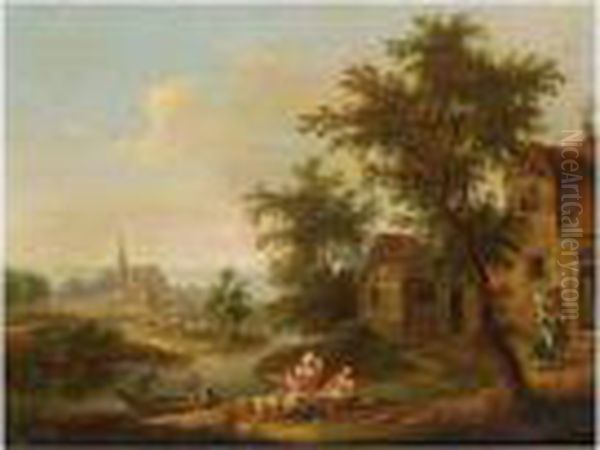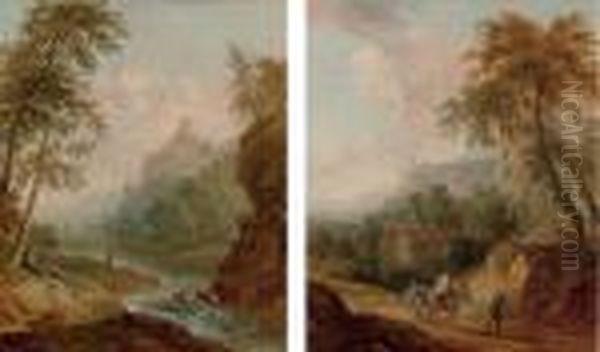Christian Georg Schütz the Elder stands as a significant figure in eighteenth-century German art. Born in 1718 in Flörsheim am Main, he carved out a distinguished career primarily in the bustling city of Frankfurt, where he passed away in 1791. His life spanned a period of transition in European art, and his work uniquely captures the evolving sensibilities towards nature and landscape, positioning him as an important precursor to the Romantic movement that would fully blossom in the following decades. Schütz dedicated his artistic endeavors almost exclusively to landscape painting, developing a reputation for his sensitive and atmospheric depictions of the natural world, particularly the scenic vistas along the Rhine River.
Frankfurt: An Artistic Hub
Frankfurt am Main, during the 18th century, was not only a major center for commerce and finance but also a vibrant hub for arts and culture. It was within this stimulating environment that Christian Georg Schütz the Elder established his practice and gained recognition. The city's status attracted patrons, artists, and intellectuals, fostering a climate where artistic innovation could take root. Schütz's presence in Frankfurt allowed him access to potential clients among the city's affluent merchants and nobility, who increasingly favored landscape paintings as decorations for their homes, reflecting a growing appreciation for nature and regional scenery. His decision to base his career there proved fruitful, enabling him to become one of the leading landscape painters of his generation in the region.
The Essence of Schütz's Style

Schütz's artistic style is characterized by a delicate balance between detailed observation and an emerging sensitivity to atmosphere and mood. He worked proficiently in both oil paint and watercolor, demonstrating versatility in capturing the nuances of light and terrain. His landscapes are often noted for their harmonious color palettes and meticulously crafted compositions. While grounded in the topographical traditions popular at the time, his works often transcend mere documentation. They evoke a sense of tranquility and picturesque beauty, hinting at the emotional engagement with nature that would become central to Romanticism. He looked closely at the world around him, rendering trees, water, and architecture with considerable care, yet always composing these elements into a pleasing, unified whole.
The Rhine River: A Central Muse
The Rhine River valley, with its dramatic gorges, rolling hills, vineyards, and numerous castles, provided Schütz with an inexhaustible source of inspiration. He became particularly renowned for his depictions of this iconic German landscape. His paintings often feature identifiable locations along the river, capturing the interplay of water, land, and sky. Elements like rustic bridges, small boats navigating the river, and distant castles perched on hilltops are recurrent motifs, adding narrative interest and a sense of place to his scenes. These Rhine views were highly sought after, appealing to both local pride and the growing interest in travel and picturesque scenery among a wider audience. His dedication to this subject matter helped solidify the Rhine's image as a quintessential German landscape.
Representative Works
Among Schütz's most recognized contributions are his comprehensive views of cities and his series depicting the Rhine. A notable example mentioned is his View of Frankfurt, which likely showcased the city's skyline and its relationship with the Main River, reflecting the civic pride and economic importance of his adopted home. Equally significant was his Set of views from the Rhine from Mainz to Cologne. This series, likely comprising multiple paintings or prints, would have offered a scenic journey along one of the most celebrated stretches of the river, capturing its diverse beauty and historical landmarks. These works exemplify his skill in combining topographical accuracy with artistic sensibility, creating images that were both informative and aesthetically pleasing. Paintings depicting smaller, intimate valleys along the Rhine also form part of his known oeuvre, showcasing his ability to capture nature on both grand and modest scales.
Precursor to Romanticism

Art historians identify Christian Georg Schütz the Elder as a key forerunner of German Romantic landscape painting. While his work retains elements of the late Baroque and Rococo aesthetics prevalent in his youth, particularly in the careful structure and sometimes idyllic portrayal of scenes, it also clearly anticipates Romantic concerns. His emphasis on specific German landscapes, the atmospheric rendering of light and weather, and the underlying sense of nature's quiet grandeur distinguish his work from purely classical or Italianate landscapes favored by artists like Nicolas Poussin or Claude Lorrain in the previous century. Schütz's focus on the native scenery and the subtle emotional resonance in his depictions paved the way for later artists like Caspar David Friedrich, who would explore the spiritual and subjective dimensions of nature more explicitly.
Nature and Observation
Schütz's paintings demonstrate a keen eye for the details of the natural world. His rendering of foliage, rock formations, and water surfaces suggests careful study from life, aligning with the Enlightenment's emphasis on empirical observation. However, he masterfully integrated these details into compositions that emphasized harmony and beauty rather than scientific accuracy alone. Some accounts suggest his work subtly reflected the changing relationship between humanity and nature during the early stages of industrialization, perhaps expressing a quiet nostalgia for a more pristine, untouched environment. This sensitivity to the character and mood of the landscape, combined with detailed rendering, marks him as a transitional figure, bridging the gap between older traditions and new artistic directions.
Artistic Context and Contemporaries
Schütz worked during a vibrant period in German art. While Italy remained a major draw, artists increasingly found inspiration in their local environments. His focus on German landscapes aligns with a broader trend seen in the work of contemporaries across Europe who were turning towards native scenery. In the German-speaking world, artists like the Swiss Salomon Gessner were exploring idyllic landscapes in poetry and etching, while painters such as Philipp Hackert gained international fame for their detailed views, often of Italy but demonstrating a similar commitment to observation. Schütz's style can be seen in dialogue with the Dutch landscape tradition of the 17th century, perhaps drawing inspiration from masters like Jacob van Ruisdael or Meindert Hobbema in their treatment of light and composition, but adapted to his German subjects and 18th-century tastes. Other notable German-speaking artists active during parts of his lifetime include Anton Raphael Mengs and Angelica Kauffman, primarily known for Neoclassicism and portraiture, and Johann Heinrich Wilhelm Tischbein, famous for his portrait of Goethe in the Roman Campagna, highlighting the diverse artistic currents of the era. Adrian Zingg, another contemporary, was also influential in landscape depiction, particularly through graphic arts.
Technique and Mediums
Christian Georg Schütz the Elder's proficiency in both oil painting and watercolor allowed him to explore different facets of landscape representation. Oil provided opportunities for rich color, textural depth, and larger formats suitable for significant commissions. His oil paintings often display a fine finish and careful layering of glazes to achieve atmospheric effects. Watercolor, on the other hand, offered immediacy and luminosity, ideal for capturing fleeting effects of light and weather, or for preparatory studies and smaller, more intimate works. His skill across these mediums contributed to his reputation and ability to meet the demands of various patrons and markets. The delicacy often associated with his watercolors aligns well with the refined sensibilities of the Rococo period, while the substance and detail in his oils look forward to later landscape traditions.
Legacy and Influence
While the provided information doesn't detail specific students or direct followers, Christian Georg Schütz the Elder's impact lies in his contribution to the elevation of landscape painting within Germany and his role as a pioneer of Romantic sensibilities. His popular Rhine views helped establish a tradition of depicting this iconic river, influencing subsequent generations of artists who traveled the region. He demonstrated that German scenery was a worthy subject for serious art, moving beyond purely topographical recording towards a more evocative and atmospheric portrayal. His success in Frankfurt and the dissemination of his work, possibly through prints derived from his paintings, ensured his influence extended beyond his immediate circle. He remains a respected figure in German art history, appreciated for the quality of his work and his position as a key transitional artist bridging the Rococo and Romantic eras. His dedication to landscape helped pave the way for the genre's prominence in the 19th century.
Distinguishing the Artist
It is important to distinguish Christian Georg Schütz the Elder (1718-1791), the landscape painter, from other notable individuals with similar names. Most significantly, he is entirely distinct from the celebrated Baroque composer Heinrich Schütz (1585-1672), who lived over a century earlier and worked in music. Furthermore, art historical records sometimes mention other artists named Schütz, including a nephew, Christian Georg Schütz the Younger (1758-1823), who followed in his uncle's footsteps as a landscape painter, and potentially later descendants as well. While family connections existed in the artistic sphere, the primary focus here is on the elder Schütz, whose career defined the family's initial prominence in Frankfurt landscape painting during the mid-to-late 18th century.
Conclusion
Christian Georg Schütz the Elder occupies a crucial place in the narrative of German art history. As a dedicated landscape painter active primarily in Frankfurt during the 18th century, he captured the beauty of his native scenery, particularly the Rhine valley, with remarkable sensitivity and skill. His work, characterized by harmonious compositions, detailed observation, and an emerging atmospheric quality, marks him as an important precursor to the Romantic movement. He successfully navigated the artistic tastes of his time, creating landscapes that appealed to patrons while subtly pushing the boundaries of the genre towards greater emotional expression and a focus on specific, local environments. Though perhaps overshadowed by the more famous Romantic painters who followed, Schütz's contribution was vital in establishing landscape painting as a significant field of artistic endeavor in Germany and in shaping the way the German landscape, especially the Rhine, was perceived and represented in art. His paintings remain admired today for their tranquil beauty and historical significance.